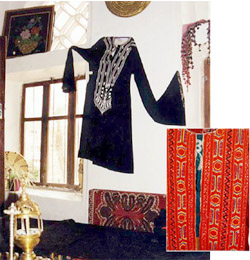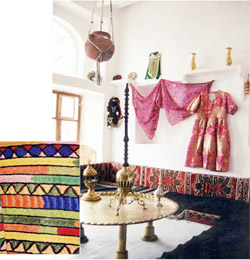
“Women’s NGO Marketing Centre Opens its Doors” [Archives:2001/21/Culture]
May 21 2001
Stephen Brichieri-Colombi
NGO Marketing Centre*

The NGO Marketing Centre is a charitable enterprise created by nine women’s NGO’s. Proceeds from sales go 50% to the women producers and 50% to the NGO’s for purchase of raw materials, salaries of trainers and their operational costs. The members of the NGO’s are a diverse group from urban and rural communities but they have one aim: to improve the educational level and standard of living of their women members and offer them a chance to engage in productive employment.
The Centre sells a variety of ceremonial and traditional artifacts as well such as the magmuq worn by women in Old Sana’a, with its intricate silver studded headpad and distinctive red and black tie-dye veil. These veils are traditionally worn on the first day of a wedding by the bride and then again for a whole month by a woman after delivering a baby. The women also sell a red and black striped weave from Wadi Dahr and the maswan, a dazzling red, gold and black handwoven cloth worn traditionally as an overcloak by women, and products made from it, mainly large lined satchels plus ‘carry alls’ made from the traditional white, red and yellow handwoven fabrics of Beit al-Faqih known as futah or lahhaf.
This is the first private marketing venture to be sponsored by women NGO’s as a group in Yemen. They have all contributed to the rent and so far have taken full responsibility for operations. Having secured this opportunity, the women NGO partners are looking forward to developing their centre as a place where high quality Yemeni handicrafts can be sold and new ideas on products and designs can be hatched and exchanged. One of the NGO’s, Al-Safa’ expresses its aims through its motto: “Life is a struggle and therefore, only through productive work will human beings achieve their objectives.”
Of all the NGO’s, Al-Safa is the most established. It has been working since 1996 as a voluntary association in a low-income district of Sana’a near the Sheraton Hotel. Al-Safa’ aims to help needy families by training them in productive, income generating activities. It sponsors literacy, weaving, embroidery and handiwork classes, training in health education, knitting, and in home economics. The NGO has about 250 paid-up members, many of whom are widows, divorcees and girls wishing to learn a profitable trade. Currently 50 women and girls are engaged in active production.
There are an additional eight NGO’s involved in the project. Al-Bushra was created in 1998. It works with low-income families in the old city of Sana’a. Its stated aim is to work in “training and capacity building of women so that they can earn a living and find ways to cope better with the society they are living in.”
Al-Shahid Al-Zubeiry, also in Old Sana’a, was formed in 1992. Before defining its activities, the NGO undertook a Needs Assessment of families living in the lanes around to identify 500 low-income families in need of help with income generation, access to food and health services. Al-Zubeiry started by undertaking welfare activities, providing food and cash to needy families and training in sewing, but now is striving to train members in production of items for sale to the foreign as well as the local market.
Al-Malik which became registered in January 2000, works in the Madbah area of Haret Malik and surrounding neighborhoods. This is one of the poorest areas in urban Sana’a, deprived of many basic services and infrastructure and far from the city amenities. It is an area for in-migrants from all governorates of Yemen and transport for trainers from the city is very costly. The NGO currently has 208 members and rents a four-room building. Like Al-Zubeiry, before setting out their program of work, Malik carried out a Needs Assessment survey in the area to determine the needs of families in greatest distress, and those of the handicapped. They have now recognized the need to secure income generating activities for their members through innovative product development and so help alleviate poverty.
One of the rural NGO partners is Al-Ulfa with 250 members, based in Qariyyit Al-Qabil village in Wadi Dahr. The NGO works in more than 35 different neighborhoods (hara) and most members are women from single parent households or girls who have completed their elementary school training but have had no possibility of access to secondary school since there is no facility nearby. These women, who want to lead a productive life, wish to be trained in skills which yield income. Like most of the partner NGOs, Al-Ulfa rent a building for their training activities paid for through subscriptions and nominal training course fees. To date, Al-Ulfa has been engaged mainly in teaching literacy, sewing, weaving, embroidery, and handicraft production. It is now re-orienting its product design towards the tourist and foreign market accessible through the NGO Marketing Centre.
Al-Yusr, which was established in 1997 and is also located in Old Sana’a, works with people from 12 harat or lanes. The objectives of the NGO are to support local initiatives in voluntary service, help needy families, extend assistance to those who need it and offer low-income families a chance to market and sell their handiwork and produce.
The experienced trainers from this NGO in the old city are now concentrating on revamping their products, training their producers to experiment with traditional stitches and transform their embroidery into silver and gold swatches suitable for framing, extravagant cushion covers, wall hangings and petite make-up bags and purses.
Two NGOs draw their members from the fringes of Sana’a. Al-Riyyan is situated in Beit Baus on the outskirts of Sana’a comprising al-Asbahi and neighboring areas. Like other peri-urban settlements, this area is densely populated. Up to now, Al-Riyyan has conducted literacy classes and skills training in sewing, embroidery, handcraft production, typing and home economics for its members. As a result of joining the Centre, it is embarking on production of artifacts and traditional Yemeni dresses for sale to the public. Al-Risha, on the other hand, is located at the opposite end of Sana’a on Ta’iz Street, in a rented basement.

Al-Khansa’ is the most rural of the nine NGO’s, based in the grape-growing region of Bani Husheish, one and a half hours from Sana’a. Al-Khansa works with 260 women agriculturalists from the surrounding area who have never before done embroidery but are now seeking skills and education to enable them to earn a cash income.
What the NGO’s have realized since the Centre opened is that women’s traditional talents in embroidery can be adapted and developed, to make products designed explicitly for both interior decor and as fashion accessories. Whereas Turkish trousers or sarawil have been traditionally produced for the Yemeni market, now the same stitches are being transferred onto make-up bags, hangings and large cushions of different sizes and shapes. Products range from dolls to jewellery boxes bound with ribbons, delicate evening bags trimmed with silver and gold disc embroidery, hand-woven wool landscapes and traditional dresses from different remote areas of the Sana’a basin, each with its own distinctive shapes, patterns and embroidery stitches.
The women NGO partners are very excited about the potential of the centre for capacity building of their own local talent, for income generation and for creative marketing schemes. They are not merely business women but look forward to taking advantage of the opportunities for training and eventual marketing of their members’ products in Yemen and abroad. The next step is to form a marketing body that will function as an independent and viable entity, while retaining NGO’s charitable status.
To ensure transparency, the NGO’s have created three committees to oversee the management of operations, one for marketing, a second for quality control and a third for pricing and auditing of accounts. At the end of the month, each NGO is required to produce an account of sales of its products together with the name of the local producer to ensure that sales from products are equitably distributed. The 2,000 to 2,500 members of the nine NGO’s, plus their dependent families, are the beneficiaries of the marketing project, both in terms of capacity building and social capital but also asset creation.
The Social Fund for Development has supported each of these NGO’s in training trainers for sewing, handicraft and literacy classes. Now, the NGO’s look forward to establishing a solid independent base and gaining access to training in marketing and product development.
To be able to remain permanently in their choice location for the future, the women will need to find additional funds. The NGO women are hoping that their collaboration and investment in the Marketing Centre will pay off and yield funds for expansion of the enterprise. If their efforts are anything to go by, they will succeed, but they need and deserve your support.
The next time you are in Old Sana’a, do drop by Haret Talha and visit this grassroots’ project. Inspect a piece of traditional Yemeni handicraft knowing that it was made by a woman producer and brought to you through a unique self-help project, the NGO Marketing Centre. Admire … and buy.
* Haret Talha, Opposite Taj Talha Hotel, Old Sana’a
——
[archive-e:21-v:2001-y:2001-d:2001-05-21-p:./2001/iss21/culture.htm]


